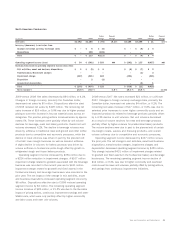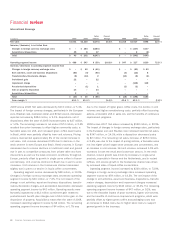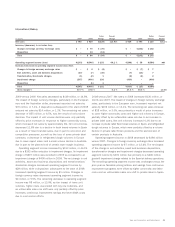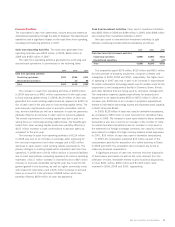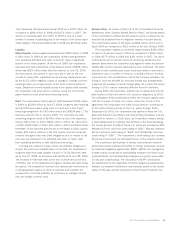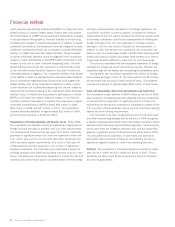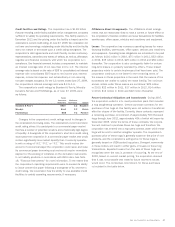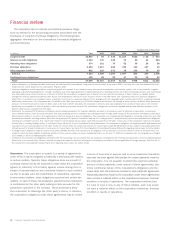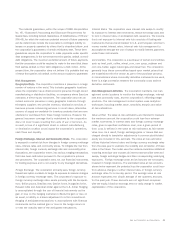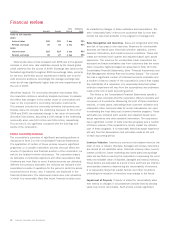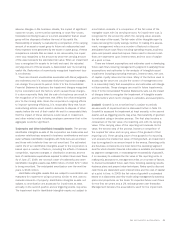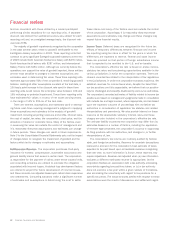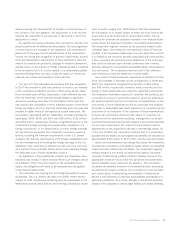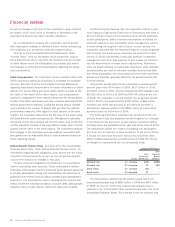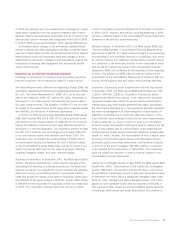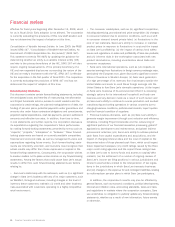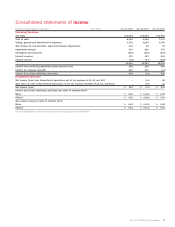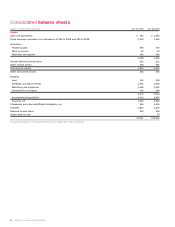Sara Lee 2009 Annual Report Download - page 40
Download and view the complete annual report
Please find page 40 of the 2009 Sara Lee annual report below. You can navigate through the pages in the report by either clicking on the pages listed below, or by using the keyword search tool below to find specific information within the annual report.
Financial review
The corporation has no material unconditional purchase obliga-
tions as defined by the accounting principles associated with the
Disclosure of Long-Term Purchase Obligations. The following table
aggregates information on the corporation’s contractual obligations
and commitments:
Payments Due by Fiscal Year
In millions Total 2010 2011 2012 2013 2014 Thereafter
Long-term debt $2,800 $÷÷«55 $÷«425 $1,164 $528 $÷25 $÷«603
Interest on debt obligations11,024 140 128 74 56 42 584
Operating lease obligations 374 101 75 52 35 25 86
Purchase obligations22,454 1,417 488 229 140 137 43
Other long-term liabilities3862 216 271 78 135 70 92
Subtotal 7,514 1,929 1,387 1,597 894 299 1,408
Contingent lease obligations4135 28 22 17 14 12 42
Total5$7,649 $1,957 $1,409 $1,614 $908 $311 $1,450
1Interest obligations on floating rate debt instruments are calculated for future periods using interest rates in effect at the end of 2009. See Note 12 to the Consolidated Financial
Statements for further details on the corporation’s long-term debt.
2Purchase obligations include expenditures to purchase goods and services in the ordinary course of business for production and inventory needs (such as raw materials, supplies,
packaging, manufacturing arrangements, storage, distribution and union wage agreements); capital expenditures; marketing services; information technology services; and maintenance
and other professional services where, as of the end of 2009, the corporation has agreed upon a fixed or minimum quantity to purchase, a fixed, minimum or variable pricing
arrangement and the approximate delivery date. Future cash expenditures will vary from the amounts shown in the table above. The corporation enters into purchase obligations
when terms or conditions are favorable or when a long-term commitment is necessary. Many of these arrangements are cancelable after a notice period without a significant penalty.
Additionally, certain costs of the corporation are not included in the table since at the end of 2009 an obligation did not exist. An example of these includes situations where purchasing
decisions for these future periods have not been made at the end of 2009. Ultimately, the corporation’s decisions and cash expenditures to purchase these various items will be
based upon the corporation’s sales of products, which are driven by consumer demand. The corporation’s obligations for accounts payable and accrued liabilities recorded on the
balance sheet are also excluded from the table.
3Represents the projected 2010 pension contribution and the projected payment for long-term liabilities recorded on the balance sheet for deferred compensation, restructuring
costs, deferred income, sales and other incentives. The 2010 projected pension contribution and subsequent years through 2016 include an annual pension contribution of 32 million
British pounds related to the terms of an agreement to fully fund certain U.K. pension obligations. The corporation has employee benefit obligations consisting of pensions and other
postretirement benefits, including medical; other than the projected 2010 pension contribution and the U.K. funding amounts, noted previously, pension and postretirement obligations
including any contingent amounts that may be due related to multi-employer pension plans, have been excluded from the table. A discussion of the corporation’s pension and postre-
tirement plans, including funding matters, is included in Notes 19 and 20 to the Consolidated Financial Statements. The corporation’s obligations for employee health and property and
casualty losses are also excluded from the table. Finally, the amount does not include any reserves for income taxes under FIN 48 because we are unable to reasonably predict the
ultimate amount or timing of settlement of our reserves for income taxes. See Note 21 to the corporation’s Consolidated Financial Statements regarding income taxes for further details.
4Contingent lease obligations represent leases on property operated by others that only become an obligation of the corporation in the event that the owners of the businesses are
unable to satisfy the lease liability. A significant portion of these amounts relates to leases operated by Coach, Inc. At June 27, 2009, the corporation has not recognized a contingent
lease liability on the Consolidated Balance Sheets.
5Contractual commitments and obligations identified under the accounting rules associated with accounting for contingencies are reflected and disclosed on the Consolidated Balance
Sheets and in the related notes. Amounts exclude any payments related to deferred tax balances including any tax related to future repatriation of foreign earnings. See Note 21 to
the corporation’s Consolidated Financial Statements regarding income taxes for further details.
38 Sara Lee Corporation and Subsidiaries
Guarantees The corporation is a party to a variety of agreements
under which it may be obligated to indemnify a third party with respect
to certain matters. Typically, these obligations arise as a result of
contracts entered into by the corporation under which the corporation
agrees to indemnify a third party against losses arising from a
breach of representations and covenants related to such matters
as title to assets sold, the collectibility of receivables, specified
environmental matters, lease obligations assumed and certain tax
matters. In each of these circumstances, payment by the corporation
is conditioned on the other party making a claim pursuant to the
procedures specified in the contract. These procedures allow
the corporation to challenge the other party’s claims. In addition,
the corporation’s obligations under these agreements may be limited
in terms of time and/or amount, and in some cases the corporation
may have recourse against third parties for certain payments made by
the corporation. It is not possible to predict the maximum potential
amount of future payments under certain of these agreements, due
to the conditional nature of the corporation’s obligations and the
unique facts and circumstances involved in each particular agreement.
Historically, payments made by the corporation under these agreements
have not had a material effect on the corporation’s business, financial
condition or results of operations. The corporation believes that
if it were to incur a loss in any of these matters, such loss would
not have a material effect on the corporation’s business, financial
condition or results of operations.



